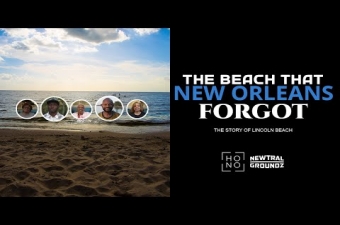Lincoln Beach
Hayne Boulevard and Vincent RoadNew Orleans LA 70128
If you were an African-American in New Orleans between 1954 and 1963, you most likely went to Lincoln Beach. It was where you picnicked with your family, had your first kiss, and danced under the stars. Lincoln Beach, a lakefront amusement park, featured everything from beauty contests and roller coasters to barrooms and restaurants — plus a stream of concerts by the best musicians around.
In the Jim Crow era, black New Orleanians had few places to cool off during the sweltering summer months. The Pontchartrain Beach amusement park with its lakefront access was restricted to white folks, and the entrance fee to the only public pool for black people was beyond the means of many. Young African-Americans swam in canals or in the dangerous currents of the Mississippi River. Some gravitated to an undeveloped stretch of shoreline where the Industrial Canal meets Lake Pontchartrain. Seabrook, as the land was called, became a city-sanctioned fishing, bathing, and picnicking area for black families. According to the Levee Board in 1929, Seabrook provided “the very best facilities for Negroes at the least expense and annoyance to the citizenship of the city.”
Over time, though, tensions with white neighbors pushed black people out of Seabrook, while a wave of waterway drowning deaths prompted African-American leaders to call for the city to create a safe swimming area. Fashioning himself a philanthropist, United Fruit Co. owner Sam “The Banana Man” Zemurray donated a snake-infested and polluted 2.3-acre plot of land in New Orleans East to the Levee Board to create a “permanent Negro beach.” He mandated that the segregated shore be named after “The Great Emancipator,” President Abraham Lincoln.
Though Lincoln Beach was born of segregation, it was integral to the New Orleans African-American experience and served as a venue for defining cultural identity. Children and teens gathered here when many public spaces were unavailable to them. If you were too young for nightclubs, Lincoln Beach was the only place where you could experience live rhythm and blues.
In between their national tour dates, hometown heroes Irma Thomas and Fats Domino regularly performed here. Local session musicians also found frequent gigs at Lincoln Beach. R&B duo the Aubry Twins got their start at a talent contest here. “Rockie” Charles Merrick — The President of Soul — told author Jeff Hannusch, “I used to enter the talent shows at Lincoln Beach in the summer. Ernie K-Doe or Aaron Neville would usually win every week, but once in 1958, I won second place and…that inspired me to go some place with music.”
The demise of Lincoln Beach came in 1964 with the federally mandated desegregation of Pontchartrain Beach, as black people gravitated to its superior facilities. This influx was unpalatable to many white New Orleanians, who availed themselves of the federally funded interstate highway to leave the urban core, and Pontchartrain Beach, behind. The amusement park’s owner, Harry Batt, began disinvesting in it until the Levee Board terminated the lease. It closed in 1983. The final concert there — promoted as “The Last Ride” — showcased headliners Irma Thomas, the Drifters, and Fats Domino. They performed to a mostly black audience as the grounds of Lincoln Beach crumbled five miles away.
A community-based effort to revitalize the area gathered momentum in the early 2020s, compelling city government to devote resources to the project. Lincoln Beach is now scheduled to reopen to the public in 2025.
Videos

"The Beach That New Orleans Forgot (Lincoln Beach Mini Documentary)" by Newtral Groundz
Video posted by Newtral Groundz.
"The Beach That New Orleans Forgot (Lincoln Beach Mini Documentary)" by Newtral Groundz
Images














